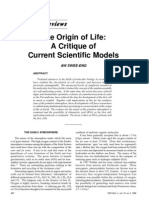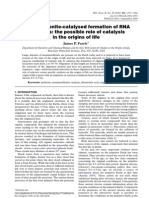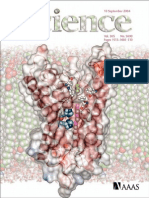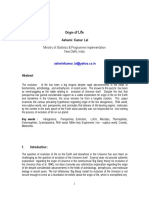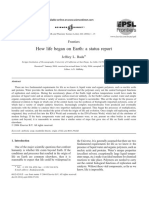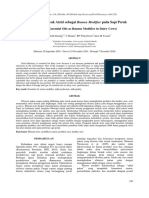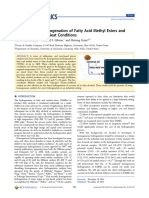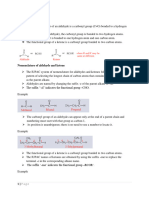The Origin and Early Evolution of Life: Prebiotic Chemistry, The Pre-RNA World, and Time
The Origin and Early Evolution of Life: Prebiotic Chemistry, The Pre-RNA World, and Time
Uploaded by
Paula FerruchoCopyright:
Available Formats
The Origin and Early Evolution of Life: Prebiotic Chemistry, The Pre-RNA World, and Time
The Origin and Early Evolution of Life: Prebiotic Chemistry, The Pre-RNA World, and Time
Uploaded by
Paula FerruchoOriginal Title
Copyright
Available Formats
Share this document
Did you find this document useful?
Is this content inappropriate?
Copyright:
Available Formats
The Origin and Early Evolution of Life: Prebiotic Chemistry, The Pre-RNA World, and Time
The Origin and Early Evolution of Life: Prebiotic Chemistry, The Pre-RNA World, and Time
Uploaded by
Paula FerruchoCopyright:
Available Formats
Cell, Vol.
85, 793–798, June 14, 1996, Copyright 1996 by Cell Press
The Origin and Early Evolution
of Life: Prebiotic Chemistry,
the Pre-RNA World, and Time
Antonio Lazcano* and Stanley L. Miller †
*Departamento de Biologı ´a
F a c u l ta d d e C i e n c i a s
Universidad Nacional Auto ´ noma de Mexico
A p a r ta d o P o s ta l 7 0 - 4 0 7
Cd Universitaria Me ´xico 04510, D.F.
M e x ic o
† Department of Chemistry and Biochemistry,
U n i v e r s i ty o f C a l i f o r n i a , S a n D i e g o
La Jolla, California 92093-0506
In the last few years, there have been a number of devel-
opments in origin oflife studies that merit review. We
will discuss primitive atmospheres, submarine vents,
autotrophic versus heterotrophic origin, the RNA and
pre-RNA worlds, and the time required for life to arise
and evolve to cyanobacteria. Topics such as prebiotic
synthesis, template polymerizations, and evolution of
specific metabolic pathways will not be discussed here.
The Primitive Atmosphere
There is no agreement on the composition of the primi-
tive atmosphere, with opinion varying from strongly re-
ducing (CH 4 N 2, NH 3 H 2 O, or CO 2 H
neutral (CO 2 N 2 H 2O).
There is no geological evidence either way, although
it is generally accepted that O 2 was absent. It is beyond
the scope of this review to explore this question, except
to comment that atmospheric chemists mostly favor
high CO 2 N 2, whereas prebiotic chemists mostly favor
more reducing conditions. Reducing conditions are re-
quired for the synthesis of amino acids, purines, pyrimi-
dines, and sugars, and such syntheses are very efficient
(Stribling and Miller, 1987). The robustness of this type
of chemistry is supported by the occurrence of most of
these biochemical compounds in the 4.6 10
Murchison meteorite, a carbonaceous chondrite, which
comes from an asteroid. The meteorite analysis results
make it plausible, but do not prove, that such syntheses
also occurred on the primitive Earth. Based on what is
known about prebiotic chemistry, if the Earth was not
reducing, then the organic compounds would have to be
brought to it by dust particles, comets, and meteorites
(Anders, 1989; Chyba et al., 1990). The amounts that
can be brought in this way and survive passage through
the atmosphere are quite small, and may not have been
sufficient for the origin oflife.
The temperature of the primitive Earth during the pe-
riod of the origin oflife is unknown. The entire planet
is generally thought, without direct evidence, to have
remained molten for several hundred million years after
its formation 4.6 10 9 years ago (Wetherill, 1990). The
oldest sedimentary rocks in the Greenland Isua for-
mation have been heated to 500 C, so the evidence on
the conditions at that time has largely been destroyed.
The sediments in the Australian Warrawoona formation
3.5 10 9 years old contain very convincing cyanobacte-
ria-like microfossils (Schopf, 1993). Some atmospheric
models incorporate high partial pressures of CO 2 to raise
the temperature of the Earth by a greenhouse effect
a n d th u s p r e v e n t th e c o m p l e te f r e e z i n g o f th e o c e a n s
(Kasting, 1993). However, a frozen Earth has some ad-
v a nta g e s fo r p re b io tic c he m is try (B a d a e t a l. , 1 9 9 4 ). B ut
again, there is no direct evidence either way. In addition,
p r o c e s s e s r e l e v a n t to th e o r i g i n o f l i f e m a y h a v e ta k e n
place in environments different from the terrestrial aver-
a g e , e . g . , h o t s p r i n g s , e u te c ti c s e a w a te r , o r d r y i n g l a -
goons.
Submarine Vents
Shortly after the discovery of submarine vents, or hot
springs, at oceanic ridge crests (Corliss et al., 1979), a
theory of the origin oflife in these vents was proposed
(Corliss et al., 1981). Considerable attention has been
given to this theory (Holm, 1992) and the other possible
roles of vents in the origin oflife, but it seems unlikely
that the vents played a role in prebiotic synthesis of
organic compounds or polymers.
The hot springs arise by sea water being forced down
into the sediments for several kilometers, heated by
magma, and pushed through the vents at 350 C. A great
deal of water is involved, with the whole ocean passing
through them every ten million years. The theory pro-
poses that organic synthesis took place during the pas-
sage of vent water down the 350 C to 2 C gradient,
followed by synthesis of peptides and other polymers,
and the conversion of these polymers to living organ-
isms in the temperature gradient. The steps in this theory
have been examined and shown not to work (Miller and
Bada, 1988). For example, organic compounds are de-
composed at 350 C rather than synthesized, and poly-
mers such as peptides, RNA, and DNA are hydrolyzed
rapidly rather than synthesized at vent temperatures.
The submarine vents did play a role in the events leading
to the origin oflife, but this role was in regulating the
composition of the ocean and possibly the atmosphere,
and, more importantly, the destruction of organic com-
pounds produced in the atmosphere. This means that
organic compounds would not accumulate over very
long periods of time, and therefore the vent destruction
sets a time frame for the origin oflife of approximately
ten million years (Stribling and Miller, 1987; Lazcano and
Miller, 1994).
The surprising occurrence of hyperthermophiles
growing at temperatures as high as 110 C (not at 350 C)
near the vents (Forterre, 1996 [this issue of Cell]), as
well as of tube worms and clams growing near the vents
at 37 C, cannot be used as an argument for the origin of
life at elevated temperatures, anymore than the present
abundance oflife on the Earth at 2 C in the ocean or 37 C
in mammals indicates an origin at these temperatures
(Miller and Lazcano, 1995).
Heterotrophic or Autotrophic Origins
The Oparin–Haldane heterotrophic theory of the origin
oflife has been widely accepted on the basis that a
heterotrophic organism is simpler than an autotrophic
one, and prebiotic synthesis experiments show how
easy it is under reducing conditions to produce organic
compounds, many of which are used in present biology.
There are, however, some recent examples of autotro-
phic proposals made for a variety of reasons.
One reason for proposing an autotrophic origin is the
CO 2-rich model of the primitive Earth’s atmosphere
(Kasting, 1993). High pressures of CO 2 (10–100 atm) im-
ply the absence of reducing conditions and organic
compound synthesis, and therefore it would be neces-
sary for the first organisms to biosynthesize their organic
compounds, or to make use of the very small amounts
of organic compounds brought in by comets and mete-
o r i te s .
An autotrophic theory involving nonenzymatic reac-
tions patterned after present biochemical pathways of
intermediate metabolism has been proposed (Hart-
mann, 1975). According to this scheme, the citric acid
cycle started with acetyl-CoA by two CO 2 fixations. The
development of such a system is envisioned to require
clays, transition state metals, and UV light. Although
there are a few biosynthetic reactions that will proceed
nonenzymatically, most do not. Cyclic pathways need
to be very efficient or they will stop working. An example
is the Krebs cycle, which stops unless the oxalacetate
lost by nonenzymatic decarboxylation is replaced. Non-
cyclic pathways are less bothered by this problem, but,
in any case, this idea has never been given an experi-
mental test.
Cairns-Smith (1982) proposed a clay mineral theory
in which the genetic information is contained in the pat-
tern ofions in the clay mineral lattice, and reproduction
is accomplished by crystal growth. The mineral system
is converted to the present biological one by an unspeci-
fied process called genetic takeover. There has been
no experimental support for this theory after 20 years,
although there were some promising reports that have
n o t b e e n c o n f ir m e d .
The most elaborate autotrophic theory is that of
Wa¨chtersha¨user (1992, and references therein), in which
biosynthesis and polymerization are postulated to take
place on the surface of FeS and FeS 2. The reaction
FeS H 2S FeS 2 H2
is a very favorable one ( G 9.23 kcal/mol; E
620 mV at pH 7 and 25 C), so the FeS/H 2S combination
is a strong reducing agent. According to this scheme,
both enzymes and nucleic acids are the evolutionary
outcome of such surface-contained archaic metabo-
lism. The FeS/H 2 S has been used to reduce double
bonds, -ketoglutarate to glutamic acid, thiols to hydro-
carbons, et cetera, (Hafenbradl et al., 1995, and refer-
ences therein). However, the FeS/H 2 S system does not
reduce CO 2 to amino acids, purines, or pyrimidines, even
though there is more than adequate free energy to do
so (Keefe et al., 1995). But the reduction of CO
cisely what is required of an autotrophic theory. The
FeS/H 2S system may have been used to reduce prebiotic
compounds synthesized by other energy sources in re-
ducing atmospheres, thereby being a component of a
heterotrophic theory of the origin oflife and Oparin’s
primitive soup.
There have been so many unsuccessful attempts to
produce prebiotic organic compounds with CO 2 N 2 H 2O
mixtures (in the absence of hydrogen) that one wonders
whether successful prebiotic syntheses are possible un-
der such conditions. Those who propose autotrophic
theories need to provide experimental evidence of how
organic compounds can be produced, and how such
systems can work. This is quite a challenge, since even
heterotrophic entities, which need only take their com-
pounds from the environment, are difficult to envision.
Autotrophic Hyperthermophiles: They May
Be Ancient, but They Are Hardly Primitive
A n o th e r r e a s o n f o r p o s tu l a ti n g a n a u to tr o p h i c o r i g i n o f
life is that the deepest branches of the universal tree of
life are occupied by anaerobic sulfur-dependent hyper-
by a reductive Krebs cycle. It is
then assumed that this metabolism is primordial, rather
than a result of extensive development (Maden, 1995).
However, it is important to distinguish between ancient
and primitive. Hyperthermophiles may be cladistically
ancient, but they are hardly primitive relative to the first
living organisms. They contain the same elaborate pro-
tein biosynthesis and most of the enzymes of modern
organisms. They seem to be no more primitive in their
replication and translation apparatus and metabolic
abilities than mesophiles (Miller and Lazcano, 1995).
Truly primitive organisms would be those of the RNA
world or some of their immediate descendents in which
a simplified version of the DNA/protein system had al-
ready appeared. In principle, the latter could be recog-
nized because they would branch off early in a universal
tree oflife, and would be endowed with simpler replica-
tion and translation machinery demonstrably not due to
secondary adaptations. However, no such organisms
have been found. The study of hyperthermophiles is
an invaluable source ofinformation on early biological
e v o l u ti o n a n d th e n a tu r e o f th e l a s t c o m m o n a n c e s to r
of all extant life forms, but an extrapolation into prebiotic
times should not be taken for granted. Since the meta-
bolic processes of the RNA world and the chemical
reactions of prebiotic times were different from present
day metabolism, phylogenetic information from extant
protein sequences can not be applied to understand
Computer Experiments on Origin of Life
There has been a school of workers applying computer
modeling to origin oflife processes (Kauffman, 1993).
These computer simulations (referred to in some circles
as experiments in silico, in contrast with in vitro or in
vivo) can model Darwinian evolution and the emergence
of order from chaotic systems. However, these calcula-
tions have so far not provided guidelines for origin of
life studies because they do not take into account the
specific properties ofindividual organic compounds and
polymers, e.g., the base pairing of AU and GC.
The discovery of catalytic RNA gave credibility to prior
suggestions that the first living organisms were self-
replicating RNA molecules with catalytic activity, a situa-
tion called the RNA world (Gesteland and Atkins, 1993).
This idea has become widely accepted, but as will be
shown below, it is unlikely that RNA itself with AUGC
and a ribose phosphate backbone is a prebiotic mole-
cule. We will refer to the period when the informational
macromolecule had a backbone t from ribose
phosphate and possibly t bases as the pre-RNA
world. The pre-RNA world is assumed to have the same
essential characteristic of the RNA world—phenotype
and genotype both reside in the same polymer, so no
protein or related catalysts are required to be synthe-
sized. Work on nucleic acids with hexoses, instead of
pentoses and pyranoses, in place o s suggest
that a wide variety o l macromolecules are
possible, even when restricted to sugar phosphate
backbones (Eschenmoser, 1994). The most interesting
nonsugar alternative is peptide nucleic acid (PNA). This
has a backbone of ethylenediamine monoacetic acid,
with the bases attached by an acetic acid, and it binds
strongly to DNA (Nielsen, 1993). The monomers of PNA
are likely prebiotic compounds, but it is not clear
whether the polymer can be formed. Since many other
alternatives are possible, RNA itself may have been the
evolutionary outcome of a series of t genetic
polymers.
The Chemical Stability of Ribose: Implications
for the Origin of Life
Recent results show that RNA itsel s an unlikely prebi-
otic molecule. The t problem is that there is no prebi-
otic reaction that gives largely ribose rather than a mix-
ture of many sugars, including those with branched
chains (Shapiro, 1988), although there is one promising
prebiotic process that might be feasible using glycolal-
dehyde phosphate as a starting reagent (Mu ¨ller et al.,
1990).
The second problem is that sugars decompose very
rapidly on the geological timescale. Thus, the half-life
for ribose decomposition is 73 min at 100 C and pH 7,
and 44 years at 0 C and pH 7. Other sugars are similarly
unstable at 100 C and pH 7, with the rate approximately
proportional to the amount o e aldehyde in the sugar.
Examples are ribose 5-phosphate (t 1⁄2 9 min), deoxy-
ribose (t 1⁄2 225 min), and ribose 2,4-diphosphate
(t1⁄2 31 min) (Larralde et al., 1995).
The instability problem could be overcome if the ri-
bose nucleosides could have formed early, because nu-
cleosides are quite stable owing to the absence o
aldehyde in its sugar. However, there is no t pre-
biotic synthesis of purine ribosides and no prebiotic
synthesis of pyrimidine nucleosides at all. Added to
these problems is the fact that any prebiotic synthesis
of ribose or nucleosides would give a racemic mixture,
and all template polymerization experiments so far show
enantiomeric cross inhibition. This is where the pres-
ence of activated L nucleosides in a template polymer-
ization of activated D nucleosides causes chain termina-
tion during polymerization (Joyce et al., 1987).
Are Polyphosphates Prebiotic?
It also has become clear that polyphosphates and acti-
vated phosphates were not abundant prebiotic com-
pounds (Keefe and Miller, 1995). There is no known
polyphosphate mineral known, and only a few kg of
calcium pyrophosphate have been found in a deposit in
New Jersey. The primitive Earth may have been
but no one has yet shown how large amounts of poly-
phosphates could have been produced. Recently, it has
been shown that phosphorus pentoxide (P 4O 10) can be
produced by heating volcanic basalts to 1200 C, and
small amounts of pyrophosphate and tripolyphosphate
have been found in a fumarole near Mount Usa in Hok-
kaido, Japan (Yamagata et al., 1991). However, the
amounts of polyphosphates produced are so small that
even greatly increased volcanic activity on the primitive
Earth would not make polyphosphates available as use-
ful prebiotic reagents, except by their concentration in
very local areas. It could be argued that the t self-
replicating systems arose in such rare environments.
We consider this to be unlikely, but such a possibility
can not be excluded altogether.
It thus follows that polyphosphates are an unlikely
prebiotic free energy source and that phosphate esters
are unlikely to have been involved in the t genetic
material. This is a very strong statement, because of the
central role that phosphates play in the metabolism of
all known organisms, but this can only be revised when
a robust prebiotic process for polyphosphate synthesis
or a plausible geochemical mechanism for concentrat-
ing them are found. One alternative is thioesters, which
are high-energy compounds (de Duve, 1991). Another
possibility is the spontaneous synthesis of a polymer
from high energy precursors, e.g., the polymerization
of glycine nitrile to polyglycine is thermodynamically
favorable, although the reaction is sluggish.
How Long Did It Take for Life to Appear?
It generally has been assumed that the origin o
took place after extended geological periods of time.
Although it is not possible to assign a precise chronology
to the events leading to the origin o , in the last few
years estimates of the available time for this to occur
have been considerably reduced. There is compelling
paleontological evidence that microbial communities
were thriving on the primitive Earth 3.5 10 9 years ago
(Schopf, 1993), and it has been suggested that life may
have been killed o as late as 3.8 10 9 years ago if
the Earth was undergoing impacts from large asteroids
(Maher and Stevenson, 1988; Sleep et al., 1989). Thus,
only 300 million years appear to be left for the origin
and early no
It has been argued that such short periods of time
make the accumulation of the prebiotic soup unlikely,
and therefore should be interpreted as evidence sup-
porting an autotrophic origin o e (Maden, 1995). As
argued below, there is no reason to assume that life
required enormous periods of time to originate and
evolve to the 3.5 10 9-year-old cyanobacteria-like War-
rawoona microfossils. The accumulation of organic
compounds of abiotic origin in the primitive oceans is
balanced by destructive processes, and if prebiotic syn-
thesis stops because of atmospheric changes, then it
would not be possible for life to arise after the organic
compounds decompose. On the other hand, the chemis-
try of prebiotic reactions is robust, and does not require
extended periods of time to take place. For instance,
the slow step in the Strecker synthesis of amino acids
is the hydrolysis of the corresponding amino nitrile to
the amide, which has a half-life of 40 years at pH 8 and
0 C (Miller and Van Trump, 1981) (half-lives of 40 years or
a process completed in 10 5 years are slow by biological
standards, but rapid on the geological time scale). An
example of a relatively rapid prebiotic synthesis is that
of amino acids on the Murchison meteorite parent body,
where it apparently occurred in less that 10 5
years (Pel-
tzer et al., 1984). Thus, although the buildup of the prebi-
otic soup may have involved millions of years, the indi-
vidual reactions to synthesized prebiotic compounds
have short half-lives, and there are no known relevant
examples of slowly synthesized molecules.
Whatever the nature of the t genetic polymer, it is
clear that hydrolysis must have limited its accumulation
in the primitive environment. An informational polymer
must have a lifetime comparable with that of the organ-
ism (Westheimer, 1987) or, at least, with the time re-
quired for its replication. Even if a slow addition of mono-
mers to a genetic polymer is envisioned, the rate of
polymer synthesis nonetheless must be rapid compared
with hydrolysis rates, especially if a t amount
of genetic information is to be contained in the polymer.
Thus, a 100-base long RNA molecule needs to be syn-
thesized at least 100 times faster than the hydrolysis
rate of a single phosphodiester bond. Even if highly
stable precursors to the ribose phosphate backbone of
RNA are proposed for the pre-RNA world, the bases
themselves will decompose over long periods of time.
For example, cytosine hydrolyses to uracil with a half-
life of 300 years at pH 7 and 25 C in single-stranded
DNA (Lindahl, 1993). Adenine, which is usually thought
to be very stable, deaminates to hypoxanthine with a
half-life of 204 days at 100 C and pH 7 (Shapiro, 1995).
This is only about ten times slower than cytosine
(t1⁄2 21 days at 100 C and pH 7). Given these stability
constraints, there is no reason to assume that the self-
organization of prebiotic compounds into a system
capable of undergoing Darwinian evolution involved ex-
tended periods of time. We envision a maximum upper
limit of 5 10 6 years, because this is the half-life for
destruction of organic compounds in the oceans owing
to their passage through the submarine vents (Lazcano
and Miller, 1994).
These stability calculations can also be used to set
an upper limit for the amount of time available for protein
biosynthesis to appear. Although the emergence of
translation was once considered the central issue in
the origin o , the discovery and characterization of
ribozymes, including the c binding of amino acids
to RNA molecules (Yarus, 1993) and the possibility that
peptidyl–transferase activity resides in the RNA compo-
nent of the ribosome (Noller et al., 1992) have given
credence to the idea that a rudimentary form of protein
synthesis originated in the RNA world. How this took
place is unknown, but it could not have been delayed
for extended periods of time owing to the decomposition
of both RNA and amino acids in aqueous solutions,
which is t even at low temperatures. Although
alanine decomposes slowly by irreversible decarboxyl-
ation (t 1⁄2 10 9 years at 25 C), other amino acids are
rather unstable. Serine and threonine have half-lives of
approximately 10 3 years at 25 C, whereas histidine and
tyrosine decompose at a much faster rate. This problem
would have been avoided if amino acid biosyntheses
were accomplished by ribozymes. It has been sug-
gested that this may be the case in histidine biosynthesis
(White, 1976), but no evidence supporting this claim is
available.
The Role of Gene Duplication in Early Cell Evolution
There is still a gap between descriptions of prebiotic
events and the last common ancestor. Intermediate
stages must have involved simpler organisms with much
smaller genomes. The question is whether it is possible
to infer some of their major characteristics. It has long
been recognized that most genetic information is not
essential for cell growth and division. Statistical analysis
of 80 randomly selected chromosomal loci for Bacillus
subtilis has led to the suggestion that the minimum cellu-
lar genome size is of the order of 562 kb (Itaya, 1995).
This e is comparable with the size of the Myco-
plasma genitalium genome, which is 580 kb long and
codes for 482 genes (Fraser et al., 1995). The compact-
ness of mycoplasma genomes can easily be understood
in terms of their parasitic lifestyle, but it is somewhat
surprising that the streamlining processes have not
greatly d the length of the genes or the number
involved in protein synthesis and DNA replication (Fraser
et al., 1995; Bork et al., 1995).
It is unlikely that such a large array of sequences
involved in replication, transcription, and translation
were already present in the t DNA/protein organisms.
Most enzymes are recognized to have arisen by gene
duplication. The uncertainty is the number of enzymes
that did not arise in this manner, i.e., the starter types.
In some cases, the starter types may stem from slow
nonenzymatic reactions where the protein improves on
a previously sluggish process, e.g., pyridoxal catalyzed
transaminations.
Based on the similarity of many biochemical reac-
tions, and on the observation that many proteins of
related function share the same ancestry within a given
organism, we estimate that the number of starter types
ranged from 20–100, but the reader might want to make
her or his own list of minimal enzymes. Analysis of the
currently available databases, including the recently
completed entire genome sequences of Haemophilus
e (Fleischmann et al., 1995) and Mycoplasma
genitalium (Fraser et al., 1995), has shown that a large
proportion of each organism’s genes are related to each
other as well as to genes in distantly related species.
All known life forms share a common pool of highly
conserved genetic information that was shaped to a
considerable extent by paralogous gene duplications
and divergence events predating the prokaryote-
eukaryote divergence.
A few examples of the wide variety of such gene dupli-
cations involved in the translation and replication ma-
chineries include: the Escherichia coli ribosomal pro-
teins, which are the result of gene duplications; the
elongation factors; aminoacyl tRNA synthetases, which
are the result of gene duplication events of two major
starter types; and DNA polymerases (cf. Lazcano and
Miller, 1994).
Evidence of extensive gene duplication supports the
contention that metabolic pathways were assembled
by the so-called “patchwork mechanism,” i.e., original
biosynthetic routes may have been mediated by primi-
tive enzymes lacking absolute substrate y
(Jensen, 1976). Sequence analysis of some universally
distributed anabolic genes like those in the histidine
biosynthetic pathway sequences support this possibility
(Fani et al., 1995). In the case of chlorophyll-dependent
photosynthesis, evidence of duplication and even dou-
ble-duplication events has been preserved in ferrodox-
ins, F-type ATPases, the reductases involved in chloro-
phyll and bacteriochlorophyll biosynthesis, the bacterial
photosynthetic reaction center, the two sets o
harvesting antennae, and photosystems I and II (cf. Laz-
cano and Miller, 1994).
Explosive Metabolic Evolution
I t is assumed that life arose in a prebiotic soup con-
taining most, if not all, of the necessary small molecules,
then there was a large potential energy supply available
on the primitive Earth from t fermentations. It is
clear that such compounds could provide both the
growth and energy supply of a large number of organ-
isms, but this would rapidly result in the depletion of
the available nutrients. Although the usual example of
a primordial fermentation is that of glucose (Oparin,
1938), it is unlikely that large quantities of this sugar
were available in the primitive environment because of
its instability. As noted by Clarke and Elsden (1980),
a more likely early fermentation reaction was that of
glycine:
glycine NADH ADP P i acetate NH 4 NAD ATP.
The primitive ocean may have had a glycine concen-
tration between 10 8–10 4 M, depending on the
ciency of prebiotic synthesis and whether the ultimate
source of organic compounds was endogenous or not.
At one mole ATP per mole of glycine, these values corre-
spond to 10 25 –10 28 cells. Such high numbers of cells
would lead to an exponential decrease in the concentra-
tion of the available fermentable organic compounds of
prebiotic origin and would bring about a metabolic crisis
that could only be overcome by the evolutionary devel-
opment o g autotrophic organisms with
CO 2 g abilities (Lazcano and Miller, 1994).
The time for evolution of the t DNA/protein or-
ganisms to oscillatorian-like cyanobacteria is usually
thought to be very long, because the latter have rather
large genomes of 6 10 3 kb to 8 10 3 kb (Herdman,
1985) and are usually considered to be very complex.
However, many of the evolutionary novelties required
for the emergence of oxygenic photosynthesis are the
result of duplication and divergence of genes. Assuming
that Archean cells had a random rate of duplicon
tion, and a rate of spontaneous gene duplications com-
parable with the present values of 10 5
–10 3 gene dupli-
cations (Anderson and Roth, 1977), the time required
for the development of a 100 kb genome of a DNA/
protein primitive heterotroph into a 7,000-genes
tous cyanobacteria would require only 7 10 6 years
(Lazcano and Miller, 1994).
It is well known that only a few weeks are required for
the rapid spread of duplicates in bacterial populations
under the stress conditions of directed evolution experi-
ments. There appear to be no experimental measure-
ments of the rate o n and n of new
enzyme activities resulting from gene duplication. How-
ever, recent results on the organophosphate and phos-
phonate hydrolyzing phosphotriesterase from Pseu-
domonas diminuta and other soil eubacteria suggest
that this new enzyme diverged by duplication from the
/ barrel family and reached the n limit in only
40 years (Scanlan and Reid, 1995). Thus, the rate of
duplication and n of new genes can be surprisingly
fast on the geological timescale.
There are a number of additional mechanisms that
could have increased the rate of metabolic evolution,
including the modular assembly of new proteins, gene
fusion events, and horizontal gene transfer as seen in
extensive antibiotic resistance in bacteria. Directed evo-
lution experiments have shown that new substrate spec-
s appear in a few weeks from existing enzymes
by recombination events within a gene (Hall and Zuzel,
1980). This suggests that mosaic proteins may have
enhanced the catalytic repertoire of ancient organisms.
It is likely that the widespread belief that the origin
and early evolution o e were slow processes requiring
billions and billions of years stems from the classical
Darwinian approach that major changes are slow and
proceed in a stepwise manner over extended periods
of time. All the evidence reviewed here suggests that
stability of monomers and polymers essential for the
origin o e strongly limited the possibility of a slow
emergence o . After the explosive metabolic evolu-
tion that took place soon after the beginning o , the
basic genetic processes and major molecular traits have
persisted essentially unchanged for more than three-
and-a-half billion years, perhaps owing to the linkages
of the genes involved and the complex interactions be-
tween t metabolic routes. At a macroevolution-
ary level, this represents a case of conservatism that is
even more striking than the maintenance of the major
animal body plans that appeared at the base of the
Cambrian, and which have remained basically un-
changed for 600 million years.
References
Anders, E. (1989). Pre-biotic organic matter from comets and aster-
oids. Nature 342 , 255–257.
Anderson, R.P., and Roth, J.R. (1977). Tandem genetic duplications
in phage and bacteria. Annu. Rev. Microbiol. 31, 473–505.
Bada, J.L., Bigham, C., and Miller, S.L. (1994). Impact melting of
frozen oceans on the early Earth: implications for the origin o
Proc. Natl. Acad. Sci. USA 91, 1248–1250.
Bork, P., Ouzounis, C., Casari, G., Schneider, R., Sander, C., Dolan,
M., Gilbert, W., and Gillevet, P.M. (1995). Exploring the Mycoplasma
capricolum genome: a minimal cell reveals its physiology. Mol. Mi-
crobiol. 16, 955–967.
Cairns-Smith, A.G. (1982). Genetic Takeover and the Mineral Origins
of Life (Cambridge: Cambridge University Press).
Chyba, C.F., Thomas, P.J., Brookshaw, L., and Sagan, C. (1990).
You might also like
- Gaia HypothesisDocument15 pagesGaia HypothesisdddfefNo ratings yet
- AP Biology Reading Guide Chapter 25Document16 pagesAP Biology Reading Guide Chapter 25Shiv Ganesh100% (1)
- The Origin and Early Evolution Review of Life: Prebiotic Chemistry, The Pre-RNA World, and TimeDocument6 pagesThe Origin and Early Evolution Review of Life: Prebiotic Chemistry, The Pre-RNA World, and TimeBraiamLeonardoAlvaradoGarzonNo ratings yet
- Tjv10n3 Origin LifeDocument15 pagesTjv10n3 Origin Lifekhes87No ratings yet
- Origin of LifeDocument37 pagesOrigin of LifeSheng JlqNo ratings yet
- Chemical Evolution of Life On The Early EarthDocument16 pagesChemical Evolution of Life On The Early EarthManureghukumar94No ratings yet
- Deep Hot Biosphere - DR Thomas Gold-PNASDocument5 pagesDeep Hot Biosphere - DR Thomas Gold-PNASzaroia100% (1)
- The Origin and Emergence of Life Under Impact Bombardment: Charles S. CockellDocument12 pagesThe Origin and Emergence of Life Under Impact Bombardment: Charles S. Cockellapi-3713202No ratings yet
- Summer Assignment Scan PDFDocument58 pagesSummer Assignment Scan PDFDavid CaseyNo ratings yet
- Petro Theory AssignmentDocument5 pagesPetro Theory AssignmentAsmadNo ratings yet
- Gaia As Seen Through The AtmosphereDocument2 pagesGaia As Seen Through The AtmosphereelgianerNo ratings yet
- A System's View of The Evolution of LifeDocument22 pagesA System's View of The Evolution of LifeKartik SrinivasanNo ratings yet
- Montmorillonite-Catalysed Formation of RNA Oligomers: The Possible Role of Catalysis in The Origins of LifeDocument10 pagesMontmorillonite-Catalysed Formation of RNA Oligomers: The Possible Role of Catalysis in The Origins of Lifeapi-3713202No ratings yet
- Sagan 1974 Origins of LifeDocument9 pagesSagan 1974 Origins of LifeRodrigo Giesta FigueiredoNo ratings yet
- Ast 2019 2203Document29 pagesAst 2019 2203Evoleth SalcedoNo ratings yet
- Box 1-C in The BeginningDocument1 pageBox 1-C in The BeginningRodrigo WolfordNo ratings yet
- Clays and The Origin of Life: The ExperimentsDocument55 pagesClays and The Origin of Life: The ExperimentsMark MaryassovNo ratings yet
- Evidences of Photosynthesis Crystalle LonganillaDocument3 pagesEvidences of Photosynthesis Crystalle LonganillaAtisha Kate FrancoNo ratings yet
- Esd 2010 2 Discussions Typeset Source Version5Document14 pagesEsd 2010 2 Discussions Typeset Source Version5Karo MichaelianNo ratings yet
- Ore Deposits and Emergence of LifeDocument20 pagesOre Deposits and Emergence of LifeVinicius GomesNo ratings yet
- A1.1 The Origins of Life - 2018Document50 pagesA1.1 The Origins of Life - 2018Wayne DayataNo ratings yet
- Chidrawi M3 Ch01Document10 pagesChidrawi M3 Ch01Victor PhamNo ratings yet
- PMC1578733Document18 pagesPMC1578733Leonardo CorreiaNo ratings yet
- Gaia TheoryDocument11 pagesGaia TheoryKSwiss RobinsonNo ratings yet
- LOVELOCK Et Al 1974 TellusDocument9 pagesLOVELOCK Et Al 1974 TellusLuis Alonso Hormazabal DelgadoNo ratings yet
- Science Magazine 5690 2004-09-10Document99 pagesScience Magazine 5690 2004-09-10WillimSmithNo ratings yet
- Atmospheric Homeostasis by and For The Biosphere The Gaia HypothesisDocument10 pagesAtmospheric Homeostasis by and For The Biosphere The Gaia HypothesiselgianerNo ratings yet
- Molecular EvolutionDocument21 pagesMolecular EvolutionSonu Rampal SainiNo ratings yet
- Mantle Potential Temperature Trend For The Central Atlantic Magmatic Province Planets, Minerals and Life's OriginDocument1 pageMantle Potential Temperature Trend For The Central Atlantic Magmatic Province Planets, Minerals and Life's Originmarquillo727No ratings yet
- origin of lifeDocument44 pagesorigin of lifeKalpana YadavNo ratings yet
- Lecture 2 Origin of LifeDocument28 pagesLecture 2 Origin of LifesimihbdNo ratings yet
- Rapid Climate Change and Climate Surprises: A Look Back and AheadDocument6 pagesRapid Climate Change and Climate Surprises: A Look Back and Aheadstone77777No ratings yet
- Four PROCESSES Needed For First Cells To Form:: Evolution Is TheDocument7 pagesFour PROCESSES Needed For First Cells To Form:: Evolution Is ThesmurplerNo ratings yet
- (Kitadai & Maruyama, 2018) Origins of Building Blocks of Life. A ReviewDocument37 pages(Kitadai & Maruyama, 2018) Origins of Building Blocks of Life. A ReviewOscar Leonardo Aaron Arizpe VicencioNo ratings yet
- Living Earth LovelockDocument2 pagesLiving Earth LovelockazertysdgfsdghNo ratings yet
- Colwell & D'Hondt - Nature and Extent of The Deep BiosphereDocument28 pagesColwell & D'Hondt - Nature and Extent of The Deep BiosphereSabyasachi BhattacharyaNo ratings yet
- Origin of Life On EarthDocument32 pagesOrigin of Life On EarthMKey ChUhnNo ratings yet
- The Earth Is A Closed System.: Questions and AnswersDocument11 pagesThe Earth Is A Closed System.: Questions and AnswersJocelyn OrtizNo ratings yet
- Biology (Mader) Exam Study GuideDocument8 pagesBiology (Mader) Exam Study GuidemizbigspendaNo ratings yet
- Introduction: Conditions For The Emergence of Life On The Early EarthDocument5 pagesIntroduction: Conditions For The Emergence of Life On The Early Earthapi-3713202No ratings yet
- Life From Space: Astrobiology and PanspermiaDocument5 pagesLife From Space: Astrobiology and PanspermiaPabloAPachecoNo ratings yet
- Sagan, L. On The Origin of Mitosing Cells. J. Theoret. Biol. (1967) 14, 225-274Document56 pagesSagan, L. On The Origin of Mitosing Cells. J. Theoret. Biol. (1967) 14, 225-274Jéssica CristinaNo ratings yet
- Introductiontolifescience 161104052948 PDFDocument48 pagesIntroductiontolifescience 161104052948 PDFZarlene SierraNo ratings yet
- 2004 The Antiquity of Microbial Sulfate ReductionDocument30 pages2004 The Antiquity of Microbial Sulfate ReductionLuciana ChequerNo ratings yet
- Black Smokers ReadingDocument3 pagesBlack Smokers ReadingSasaNo ratings yet
- The Historical Development of The Concept of Life: Lesson 1Document43 pagesThe Historical Development of The Concept of Life: Lesson 1Ohm PawatNo ratings yet
- Ingredients For Microbial Life Preserved in 3.5 Billion-Year-Old Fluid InclusionsDocument11 pagesIngredients For Microbial Life Preserved in 3.5 Billion-Year-Old Fluid InclusionsFernandoNo ratings yet
- Christian Paul P. Buado - Bsge-1A 1. What Was The Original Source of The Material Form Which The Solar-System Is Derived?Document4 pagesChristian Paul P. Buado - Bsge-1A 1. What Was The Original Source of The Material Form Which The Solar-System Is Derived?David SamuelNo ratings yet
- TOEF Complete The Summary and Table Completion QuestionsDocument7 pagesTOEF Complete The Summary and Table Completion QuestionsHamod KingNo ratings yet
- L2 - Q2 - Introduction To Life ScienceDocument41 pagesL2 - Q2 - Introduction To Life ScienceMJ CaparidaNo ratings yet
- Astrobiology: Dr. Oliver Botta, Goddard Space Flight Center and International Space Science InstituteDocument17 pagesAstrobiology: Dr. Oliver Botta, Goddard Space Flight Center and International Space Science InstituteAnitaVasquezNo ratings yet
- Origin of The Earth's Atmosphere: When Did All This Occur?Document21 pagesOrigin of The Earth's Atmosphere: When Did All This Occur?RachelNo ratings yet
- How Life Began On EarthDocument15 pagesHow Life Began On EarthDilan9318No ratings yet
- Wa0017Document18 pagesWa0017Datum VivelacriqueNo ratings yet
- The Carbon Cycle On Early Earth-And On Mars?: Monica M. Grady and Ian WrightDocument11 pagesThe Carbon Cycle On Early Earth-And On Mars?: Monica M. Grady and Ian Wrightapi-3713202No ratings yet
- Power Point in Biology 2Document25 pagesPower Point in Biology 2ROJANE FLORANo ratings yet
- Down To Earth: OOK EviewsDocument1 pageDown To Earth: OOK Eviewsjuan manuelNo ratings yet
- Elemental: How Five Elements Changed Earth’s Past and Will Shape Our FutureFrom EverandElemental: How Five Elements Changed Earth’s Past and Will Shape Our FutureNo ratings yet
- Acids and Bases..Document5 pagesAcids and Bases..rachelNo ratings yet
- Dyes BookDocument93 pagesDyes BookSebastian OchoaNo ratings yet
- Documentation in Science 9: Activity#4: Which Bananas Will Ripen Faster?Document4 pagesDocumentation in Science 9: Activity#4: Which Bananas Will Ripen Faster?Delta [GD]0% (1)
- Quantitative Estimation of Casein in Different Milk Samples: Science Journal of Analytical Chemistry July 2020Document5 pagesQuantitative Estimation of Casein in Different Milk Samples: Science Journal of Analytical Chemistry July 2020INCOGNITO PLYRNo ratings yet
- Polymerase Chain ReactionDocument20 pagesPolymerase Chain ReactionGuadalupe Berber100% (1)
- First Schedule Tariff ChangesDocument38 pagesFirst Schedule Tariff ChangesSamiNo ratings yet
- Research Findings On Maize, The Golden Crop by Wakasiaka MwichabeDocument10 pagesResearch Findings On Maize, The Golden Crop by Wakasiaka MwichabeSimiyu FranklineNo ratings yet
- Home Food PreservationDocument3 pagesHome Food PreservationTSN InternetNo ratings yet
- GS40 ManualDocument25 pagesGS40 ManualOri CaspiNo ratings yet
- Pemanfaatan Minyak Atsiri Sebagai Rumen Modifier Pada Sapi PerahDocument12 pagesPemanfaatan Minyak Atsiri Sebagai Rumen Modifier Pada Sapi Perah20-074 Gita YudistiraNo ratings yet
- 7.1 Acid and BasesDocument76 pages7.1 Acid and BasesMOHAMAD FIRDAUS BIN HARUN KM-PensyarahNo ratings yet
- Alcohols, Phenols and Ethers (CBSE)Document25 pagesAlcohols, Phenols and Ethers (CBSE)Vishu Bansal100% (1)
- Phylum AnnelidaDocument3 pagesPhylum AnnelidaDietAko CabalicanNo ratings yet
- BiochemistryDocument21 pagesBiochemistrysailaja kontiliNo ratings yet
- 160930115120Document47 pages160930115120Vinh HoangNo ratings yet
- Full Report - GeofoamDocument59 pagesFull Report - GeofoamVivace SystmNo ratings yet
- Synthesis of Substituted Phthalocyanines-1Document74 pagesSynthesis of Substituted Phthalocyanines-1frankdebruin261No ratings yet
- Experimental Analysis of Tobacco Seed Oil Blends With Diesel in Single Cylinder Ci-EngineDocument5 pagesExperimental Analysis of Tobacco Seed Oil Blends With Diesel in Single Cylinder Ci-EngineseventhsensegroupNo ratings yet
- Nucleophilic Substitution Reactions LectureDocument28 pagesNucleophilic Substitution Reactions LectureYu QingNo ratings yet
- PRS645Document40 pagesPRS645Eszter SzerencsiNo ratings yet
- Homogeneous Hydrogenation of Fatty Acid Methyl Esters and Natural Oils Under Neat ConditionsDocument5 pagesHomogeneous Hydrogenation of Fatty Acid Methyl Esters and Natural Oils Under Neat ConditionsEnrique GallegosNo ratings yet
- PCB Case StudyDocument3 pagesPCB Case Studyapi-241125262No ratings yet
- Addition-Elimination Special NotesDocument18 pagesAddition-Elimination Special NotesJawad MughalNo ratings yet
- 2014 H2 Alkanes Tut (Teachers)Document14 pages2014 H2 Alkanes Tut (Teachers)Chen ZhihaoNo ratings yet
- Alcohol, Phenol and EthersDocument25 pagesAlcohol, Phenol and EthersZunaira NoreenNo ratings yet
- Aldehyde and KetoneDocument7 pagesAldehyde and KetoneAbiot DibabaNo ratings yet
- Evers Lik 1201 TdsDocument2 pagesEvers Lik 1201 TdschristianNo ratings yet
- Using Biodynamic To Eliminate WeedsDocument6 pagesUsing Biodynamic To Eliminate WeedsPennsylvania Association for Sustainable Agriculture100% (1)
- Biotechnology ReviewerDocument5 pagesBiotechnology ReviewerDonnabelle VaronaNo ratings yet
- Edu 214 Biological JeopardyDocument51 pagesEdu 214 Biological Jeopardyapi-438884957No ratings yet




